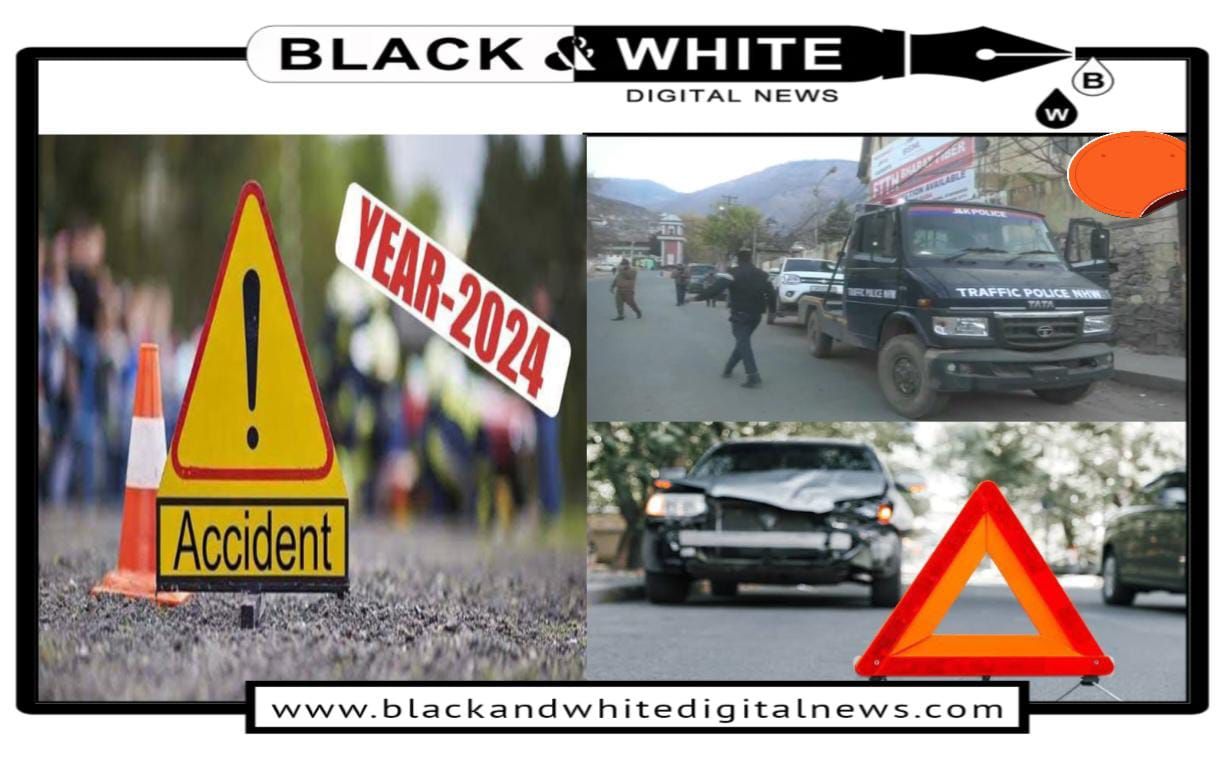Jammu and Kashmir: A Grim Toll of Road Accidents Highlights Urgent Need for Reforms
||Black and White Digital News ||
||Parvinder Singh December 25,2024 ||
JAMMU : The roads of Jammu and Kashmir have become increasingly perilous, with the first ten months of 2024 witnessing 703 fatalities in 6,820 road accidents. This staggering loss of life underscores the region’s struggle with road safety despite heightened enforcement and awareness campaigns. The National Highway and other roads cutting through the hilly terrains of the Union Territory have proven deadly, demanding urgent attention to address systemic failures.
Traffic police in the region have ramped up their operations, issuing over 12 lakh challans to violators in the same period. These include penalties for over-speeding, reckless driving, and failure to adhere to safety norms like helmet and seatbelt usage. However, the high fatality rate illustrates that punitive actions alone are insufficient to curb the crisis.
Poor road conditions, especially in hilly areas, remain a significant issue. Narrow roads, absence of crash barriers, improper drainage systems, and insufficient signage contribute to the rising number of accidents. Factors like reckless driving, over-speeding, and negligence compound the situation, creating a perfect storm of danger for road users.
A Closer Look at the Data:
District-level statistics reveal the widespread nature of the problem:
Jammu: 910 accidents with 55 fatalities.
Srinagar: 443 accidents leading to 79 deaths.
Udhampur: 138 accidents resulting in 42 deaths.
Monthly trends show October as particularly deadly, recording 503 accidents and 82 fatalities. The data also indicates a troubling rise in incidents involving two-wheelers, often due to the lack of helmets and safe driving practices.
Challenges of Terrain and Infrastructure:
Jammu and Kashmir’s unique geography poses additional challenges. Hilly areas are notoriously difficult to navigate, with steep inclines, sharp curves, and unpredictable weather conditions. These natural difficulties are exacerbated by inadequate infrastructure:
– Roads in disrepair, with potholes and weak pavements.
– Absence of retaining walls and crash barriers in high-risk zones.
– Insufficient lighting and poor visibility, especially during harsh winters.
Efforts by the Traffic Police:
Despite these challenges, the traffic police have shown commendable dedication. Their stringent enforcement measures have created some deterrence. Yet, the sheer volume of violations indicates that awareness and compliance remain low. The police have also taken steps to educate the public about safe driving practices, but systemic issues limit their impact.
The loss of 703 lives is not just a statistic; it represents shattered families and communities. Many victims are young breadwinners, leaving their dependents in financial and emotional turmoil. Beyond the fatalities, thousands suffer life-altering injuries, adding to the socio-economic burden.
Tackling this crisis requires a multi-faceted approach:
1.Infrastructure Development: Upgrading road conditions, adding crash barriers, widening lanes, and improving drainage systems are critical.
2.Technology Integration: Using automated enforcement tools like speed cameras and traffic monitoring systems can enhance compliance.
3.Behavioral Change: Large-scale awareness campaigns focusing on seatbelt and helmet usage, safe driving practices, and the dangers of over-speeding.
4.Policy Overhaul: Stricter penalties for violations, better coordination between road authorities, and mandatory vehicle fitness checks.
5.Focus on High-Risk Areas: Targeted interventions in accident-prone zones, particularly in hilly regions, to address specific challenges.
Jammu and Kashmir’s alarming road accident statistics serve as a wake-up call for all stakeholders. While the traffic police deserve credit for their efforts, the crisis demands a holistic strategy combining robust infrastructure, technological enforcement, and public education. Only then can the region hope to make its roads safer and reduce the tragic toll on human lives.




